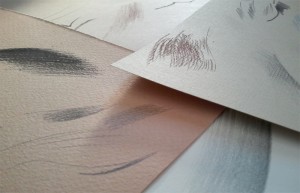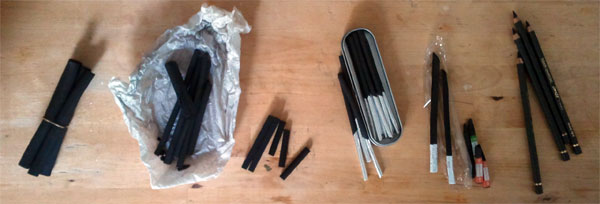The search for the perfect drawing paper:
As an artist you are likely to take an interest the paper you’re using. If you don’t, you should. It’s important for several reasons:
-
Ease of use
-
Finish desired
-
Marks required
-
Duration of work
-
Scale of work
-
Longevity
This post is about the importance of your choice of drawing paper in relation to your drawing style and process. The second part of this mini-series discusses archival concerns and conservations issues.
Ease of use:
Your paper needs to work well with the techniques you are likely to use. For example if you are working in watercolour or other wet media you should be look at heavier weight papers which are sized with gelatin. If you use a lightweight cartridge paper it will cockle and the surface will probably disintegrate after a couple of washes.
The same principle applies to drawing and although the effects are less obvious it is better to be working with your paper rather than against it. There are a few factors to consider:
Finish desired
Suprisingly this is, in my view, the least important factor since a highly polished finish can readily (though not necessarily easily!) be obtained on heavily textured paper; charcoal cast drawings on Roma paper are a classic example.
It is much easier to produce a finer finish on smoother paper but smoother surfaces typically withstand less reworking before the surface shows signs of damage that would be detrimental to the finished drawing.
Marks required
Again if you are making small, fine or very delicate marks it is easier to do so on a smoother surface. Even strong gestural marks can benefit from the crisp finish of a smooth paper.
If you want to display more texture or to highlight the immediacy of your work then a textured paper may be much more suitable but it is unlikely that you will be able to retain the texture if you rework the drawing.
Duration of work
If you plan to make a careful study drawing, or any drawing that will be reworked many times you will want a very robust paper. Again cast drawing is a classic example. Over the several weeks it may take to complete the drawing many passages will be reworked over and over and over….. You will not be pleased if your paper disintegrates especially as you get near to completing your drawing and have invested weeks to time and effort.
This is one reason for spending a little more money for a better quality paper. The best papers can seem very expensive but how much is £/€/$10 when compared to a week, or more of your time?
Scale of Work
Making a small drawing on heavily textured paper makes it very difficult to show any level of detail. Equally a very large drawing may benefit from added texture when the larger pattern dissolves as you move closer to it, and from the dithering effects of texture at a greater distance.
Experimental fascination
Below are some of my tests of some of my usual drawing media on a variety of different surfaces:
I would encourage you to try your own experiments too. I’ve found it quite fascinating to change material and surface combinations regularly because it forces me to focus on a different aspect of drawing each time, for example, working with inks with a brush focussed my attention on shape and edges, whereas using pen and ink I had to think about descibing form with line. In graphite I find it hard to get consistent value relationships but in charcoal (one of my favourite media) I tend to focus on using the light to turn the forms.
Each surface and material combination also has its own language of marks and techniques that work well, sometimes it can take a while to find these but the exploration of the possibilities offers its own reward in the discoveries made along the way.
Which is your preferred paper?

